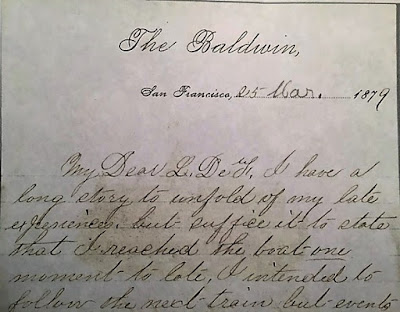 |
| Josephine Walcott to Linda de Force Gordon, November 3, 1878 (Bancroft Library, University of California-Berkeley) |
Both women were spiritualists
as well as suffragists. A trance medium with superb oratorical abilities, Linda
often represented the suffrage movement in the political sphere. Correspondence
between the two women shows their
collaboration.
“I lectured successfully at
San Jose and found many liberal pleasant friends,” Josephine reported to Linda in
1878. “It is only among liberal people that woman can find sympathy, or
audience to give utterance to her thought.” But further on, Josephine
confided: “I begin to feel that there is nothing quite worth doing. Why should
we pour forth the rich largess of our thought upon deaf ears?”
She persevered, however. In
1880, the California State Legislature received “A petition from Mrs. Josephine Walcott
and one hundred and eighteen others, asking for legislation such as will permit
women to vote on all school questions.”
 |
| Josephine Walcott wrote to Linda de Force Gordon from San Francisco's luxurious Baldwin Hotel, 1879 |
She must have been very proud
that her daughters, Mabel and Maude, matriculated at Berkeley the following
year. Both became teachers. Maude married a professor at San Jose State College
and Mabel married William Adam Beatty, son of a policeman, who became a lawyer
in San Francisco. Tragically, Maude and Mabel died young. But Mabel and William
had a son, Willard (see earlier post), who grew up to be a brilliant
progressive educator.
Josephine made an appearance with
baby Willard in a dissertation written by the first female recipient of a PhD
at Berkeley, Milicent Washburn Shinn. Considered a pioneer in developmental
psychology, Milicent asked several young mothers – all Berkeley alumnae – to record
information about their children’s first few years. Her thesis, Notes on the Development of a Child,
includes Mabel’s descriptions of Willard.
Here, I have to interrupt the
story to say that it is extraordinary if not unheard-of to have a detailed
account of a baby, whose life’s work would involve the study of child
development, learning how to walk in 1892.
Charmingly, Mabel reported:
On
the same day on which he first took his hand thus off a chair to walk alone, he
started to walk from his grandmother to me, but when he had gone half way, and
I held out my arms to receive him, he suddenly whirled about and walked back to
his grandmother, evidently pleased that he had played a joke on me.
Josephine surely enjoyed the joke.
After Willard was orphaned in
1901, he became the ward of his uncle Earle. Josephine shared their apartment. She
died in 1906 a few months after the San Francisco Earthquake and five years
before California voted for a proposition granting women the right to vote in
state elections. From a conversation with one of Willard’s granddaughters,
I know that she read her poems to him.
https://www.throughthehourglass.com/2015/11/onward-josephine-walcott.html
See also 2015 posts: November 4 + 11 + 29 + December 2; January 12 + 16, 2016.
https://www.throughthehourglass.com/2015/11/onward-josephine-walcott.html
See also 2015 posts: November 4 + 11 + 29 + December 2; January 12 + 16, 2016.




No comments:
Post a Comment